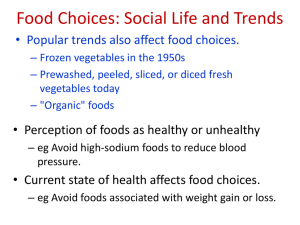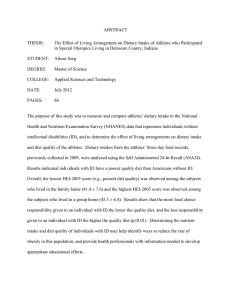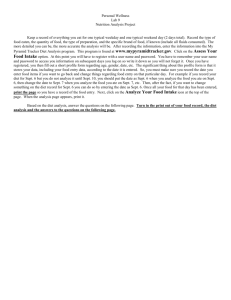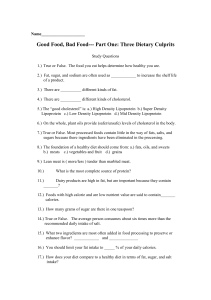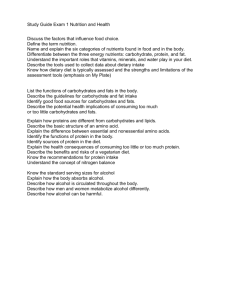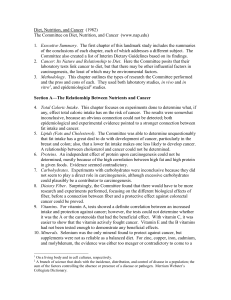Nutrition Diet Project worksheet
advertisement
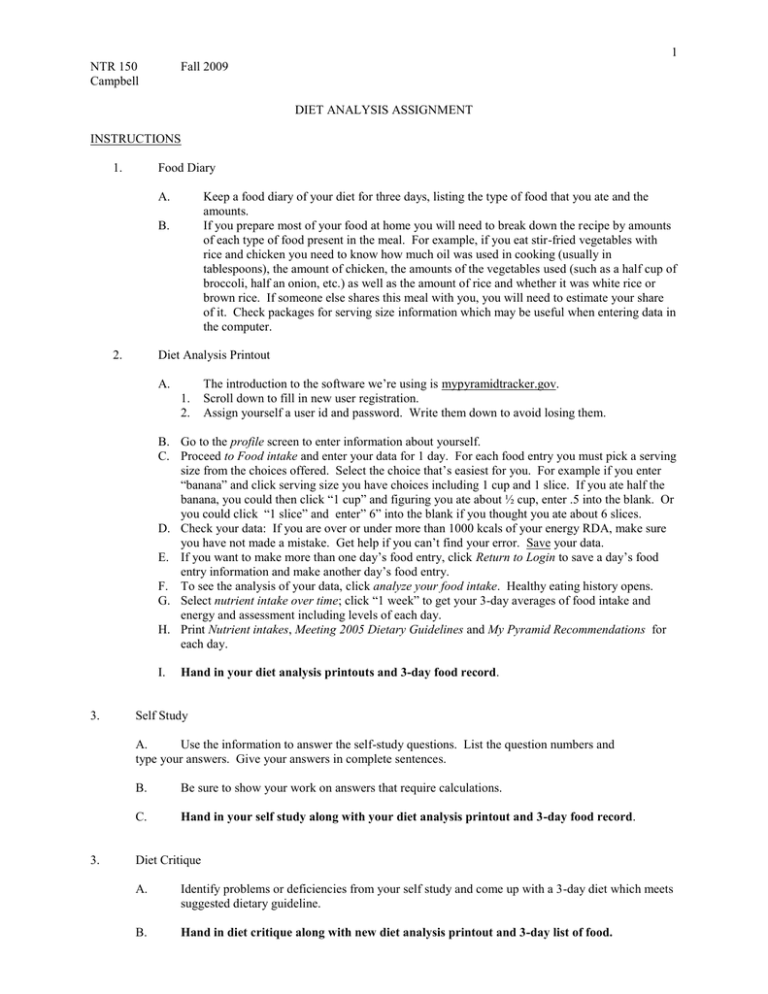
1 NTR 150 Campbell Fall 2009 DIET ANALYSIS ASSIGNMENT INSTRUCTIONS 1. Food Diary A. Keep a food diary of your diet for three days, listing the type of food that you ate and the amounts. If you prepare most of your food at home you will need to break down the recipe by amounts of each type of food present in the meal. For example, if you eat stir-fried vegetables with rice and chicken you need to know how much oil was used in cooking (usually in tablespoons), the amount of chicken, the amounts of the vegetables used (such as a half cup of broccoli, half an onion, etc.) as well as the amount of rice and whether it was white rice or brown rice. If someone else shares this meal with you, you will need to estimate your share of it. Check packages for serving size information which may be useful when entering data in the computer. B. 2. Diet Analysis Printout A. 1. 2. The introduction to the software we’re using is mypyramidtracker.gov. Scroll down to fill in new user registration. Assign yourself a user id and password. Write them down to avoid losing them. B. Go to the profile screen to enter information about yourself. C. Proceed to Food intake and enter your data for 1 day. For each food entry you must pick a serving size from the choices offered. Select the choice that’s easiest for you. For example if you enter “banana” and click serving size you have choices including 1 cup and 1 slice. If you ate half the banana, you could then click “1 cup” and figuring you ate about ½ cup, enter .5 into the blank. Or you could click “1 slice” and enter” 6” into the blank if you thought you ate about 6 slices. D. Check your data: If you are over or under more than 1000 kcals of your energy RDA, make sure you have not made a mistake. Get help if you can’t find your error. Save your data. E. If you want to make more than one day’s food entry, click Return to Login to save a day’s food entry information and make another day’s food entry. F. To see the analysis of your data, click analyze your food intake. Healthy eating history opens. G. Select nutrient intake over time; click “1 week” to get your 3-day averages of food intake and energy and assessment including levels of each day. H. Print Nutrient intakes, Meeting 2005 Dietary Guidelines and My Pyramid Recommendations for each day. I. 3. Hand in your diet analysis printouts and 3-day food record. Self Study A. Use the information to answer the self-study questions. List the question numbers and type your answers. Give your answers in complete sentences. 3. B. Be sure to show your work on answers that require calculations. C. Hand in your self study along with your diet analysis printout and 3-day food record. Diet Critique A. Identify problems or deficiencies from your self study and come up with a 3-day diet which meets suggested dietary guideline. B. Hand in diet critique along with new diet analysis printout and 3-day list of food. 2 SELF STUDY Instructions 1. 2. 3. 4. 5. 6. 7. 8. Use the information from your 3-day record to answer the following questions. Please type (keyboard) your answers. Double space between answers to one question and the next. List the question numbers so it’s clear which question you are answering. Questions should be answered in thoughtful detail. Yes or no answers will get no credit. If a question doesn’t apply to you, please state why. Answer must be scientifically supported. Answers such as “I feel like my protein intake is okay” will receive a minimal grade. Be sure to show your work on answers that require calculations. (these are indicated by **) Turn in your assignment on time (that is, during the first 10 minutes of class on the day it is due). Self Study #1: Examine your carbohydrate intake. Using your computer nutritional analysis, answer the following questions. 1. How close is this food record to the way you normally eat? 2. How many grams of carbohydrate do you consume in an average day? **How many kcals is this? 3. What percentage of your total kcals is contributed by carbohydrate as shown on your computer printout? What is recommended? How does your intake compare? 4. A very physically active person may need 65% of kcals from carbohydrate. Describe (in detail) how physically active you are. 5. How many grams of dietary fiber did you average? **How does this compare with the guideline of 5 to 6 grams per 500 kcal intake? If your diet is low in fiber, how could you increase your intake? 6. How evenly spaced are your meals? Do you tend to eat on the run? What about snacks? 7. How did your carbohydrate choices compare to recommended levels in grains, fruits & vegetables? Were any of your vegetable choices cruciferous? (What are cruciferous vegetables?) 8. What about total daily variety? Did you tend to get most of your fruit and vegetable servings from the same foods or from a variety? 9. Define the terms whole foods and processed foods. a. Were your food choices mostly whole or processed? b. List examples of the foods you ate in these 2 categories to support your answer. Self Study #2 Examine your Fat Intake 1. **How many kcals of fat do you consume on the average day? 2. What percentage of your total kcals comes from fat? How does this compare with the recommendation of no more than 35% total kcals from fat? 3. **What percentage of your total kcals comes from saturated fat? How does this compare with the guideline of no more than 10% of total kcals from saturated fat? 4. List the major sources of fat in your diet. If your fat consumption is higher than recommended, what specific foods could you cut down on or eliminate in your diet to reduce your fat intake? 3 5. How much cholesterol did you consume on average? How does this compare with the guideline of no more than 300 mg daily? If it was higher, what foods contributed most? 6. To lose weight, keeping to 20% of total kcals from fat works well (in combination with moderate aerobic exercise like walking). **How many grams of fat would you limit yourself to if you wanted to stay at 20% of kcals from fat? 7. Since too much dietary fat is believed to be a cancer promoter, the American Cancer Society recommends limiting total fat intake to 20% or less. Even if you think that you do not need to lose weight (question number 6), do you feel it would now be appropriate to make a change in your fat intake to decrease your risk of cancer. (Note: of course, since many cancer cases are caused by cigarette smoking, the biggest risk remover would be to remove the carcinogen, cigarettes.) Self-Study #3: Examine your protein intake 1. How many grams of protein did you consume in a daily average? 2. What percentage of your total kcals comes from protein? 3. Is your intake higher or lower than the RDA for protein for someone of your weight and age? 4. If you consumed either more or less than an appropriate protein intake for you, what foods could you add, subtract or eat more or less of from your 3 record keeping days? 5. Is your diet vegetarian, semi vegetarian, lacto-ovo vegetarian, lacto-vegetarian, vegan, macrobiotic, fruitarian, or omnivore? 6. If you are a vegetarian, does your diet meet the serving recommendations of the vegetarian Food Group Pyramid? If not, what changes would you suggest? Self Study #4: Examine your vitamin intake 1. Look at your average 3-day intake and fill in the following information. Vitamin Percent RDA Vitamin A ____ Thiamin ____ Riboflavin ____ Niacin ____ Vitamin B6 ____ Vitamin B12 ____ Folic acid (folate)____ *Vitamin C *the RDA of vitamin C for smokers is 125mg for men and 110 mg for women 2. Is your intake of any of these vitamins under the RDA? If so, which ones? What particular foods that are high in any of these vitamins could you REALISTICALLY*** add to your daily diet? ***foods that you like to eat, can afford and will prepare 3. Are you taking any vitamin supplements that help boost the amounts that you have listed? What percent of the RDA is in the supplements you are taking? Self Study #5: Examine your mineral intake 1. What was your average daily intake of calcium? What percentage of your RDA did you consume? What foods contributed most calcium to your diet? If you were low in calcium what foods could you realistically add? 4 2. What is your average daily sodium intake? How does this c compare to the DRV? If you are over this amount, what foods could you cut down on? 3. What is your average daily intake of potassium and what percentage of your RDA is this? Often the more processed the foods the less potassium these foods contain. Do you tend to eat highly processed foods (TV dinners, fast food, etc.)? 4. What foods do you eat often that are especially high in potassium? 5. What is your average daily intake of iron and what percentage of your RDA is this? If you are under the RDA, which foods could you add to get more iron? 5 NTR 150 DIET CRITIQUE DUE NOV. 19 Instructions: Keyboard your answers. Double space between one question and the next. Show your work on all answers in which you are asked to make calculations. 1. Determine your total average daily energy output (be sure to show your calculations including show how you derived your EER **). a)Figure your PA: Use the table below. For further information refer to your text. Men women Sedentary 1.0 1.0 Low active 1.11 1.12 Active 1.25 1.27 Very active 1.48 1.45 PA Typical daily living Plus 30-60 min moderate activity Plus >60 min moderate activity Plus >60 min moderate activity and 60 min vigorous or 120 min moderate activity b)Figure your EER** To determine your estimated energy requirements (EER), use the appropriate equation, inserting your age in years, weight (wt) in kilograms, height (ht) in meters, and physical activity (PA) factor. (To convert pounds to kilograms, divide by 2.2; to convert inches to meters, divide by 39.37.) For men 19 years and older: EER = [662 – (9.53 x age)] + PA x [(15.91 x wt) + (539.6 x ht)] For women 19 years and older: EER = [354-(6.91 x age)] + PA x [(9.36 x wt) + (726 x ht)] REMINDER: Do calculations within the parentheses first. Do calculations within the brackets next. Do multiplication before addition. If you are pregnant, additional kcals to be included: 1st trimester + 0 kcals 2nd trimester +340 kcals 3rd trimester +452 kcals 2. Design a 1-day diet that will maintain energy balance and fulfill all your recommended nutritional needs (energy, protein, dietary fiber, vitamins and minerals) to prevent deficiencies but without exceeding the Dietary Guideline recommendations for sodium, protein, total fat, saturated fat, and cholesterol. Ideally you should be able to make modifications to the information from your self-study. If you would rather start over to design a diet, that is also acceptable. Please note that this modified diet is to be based on currently accepted nutritional standards as outline in your text. I am not trying to make anyone eat in a way that does not feel right for you personally. The purpose of this exercise is to use a close approximation of your own diet as a tool for understanding the principles of nutrition science. Include all calculations. Base your calculations on your 1-day diet. 1. Energy output (EER): is it more or less than your energy input of your new 1-day diet? 2. What percentage of your total kcal is contributed by carbohydrates**? How does this compare with the recommended guidelines (recommendation 45-65% of kcals)? 3. How much dietary fiber did you average on your new 3-day analysis**? What is recommended? (Use 6 grams fiber per 500 kcal intake.) 6 4. What percentage of your total kcal comes from fat**? Compare it to the recommendation (20 – 35%) or 0.8g/kg/day. a. What percentage of your total kcal comes from saturated fats**? What is the recommendation? b. How much cholesterol is in your average daily diet? What is the recommendation? c. Are you within the recommended guidelines for total fat, saturated fat, and cholesterol? 5. What percentage of your total kcal comes from protein**? Compare it to the recommendation (10-35%) a. If you are a vegetarian (if not, skip) how are you combining protein sources to ensure your intake of complete proteins? List the daily combinations. 6. What are your amounts and goal percentages of the RDA’s for vitamins A, C, B6 and B12? Come to within at least 80% of the RDA by adding foods or fortified foods. (For this exercise, no supplements.) a. What fruits or vegetables containing beta carotene did you use in your diet? These include colorful plant foods such as: sweet potatoes, carrots, spinach, cantaloupe, kale, bok choy, broccoli, collards, swiss chard, mustard greens, winter squash, mangoes, apricots, peaches, papaya, and pumpkin. b. What were your major sources for the other antioxidant vitamins C & E? c. Which cruciferous vegetables did you include in your diet? (such as kale, bok choy, collards, broccoli, cauliflower, swiss chard and mustard greens) 7. List your daily intake of (include amount and goal % for): calcium, potassium, iron, magnesium, phosphorous, zinc, and sodium (you don’t need to show goal % for sodium). a. What is the DRI for sodium? b. What foods did you add or subtract from your first diet (diet self-study) to meet these goals? Hand in 1-day diet, Nutrient Intake print out, Dietary Guidelines print out
